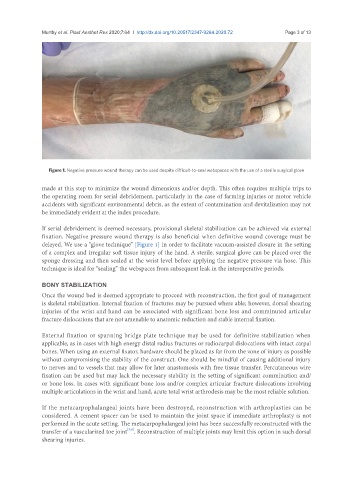Page 753 - Read Online
P. 753
Murthy et al. Plast Aesthet Res 2020;7:64 I http://dx.doi.org/10.20517/2347-9264.2020.72 Page 3 of 13
Figure 1. Negative pressure wound therapy can be used despite difficult-to-seal webspaces with the use of a sterile surgical glove
made at this step to minimize the wound dimensions and/or depth. This often requires multiple trips to
the operating room for serial debridement, particularly in the case of farming injuries or motor vehicle
accidents with significant environmental debris, as the extent of contamination and devitalization may not
be immediately evident at the index procedure.
If serial debridement is deemed necessary, provisional skeletal stabilization can be achieved via external
fixation. Negative pressure wound therapy is also beneficial when definitive wound coverage must be
delayed. We use a “glove technique” [Figure 1] in order to facilitate vacuum-assisted closure in the setting
of a complex and irregular soft tissue injury of the hand. A sterile, surgical glove can be placed over the
sponge dressing and then sealed at the wrist level before applying the negative pressure via hose. This
technique is ideal for “sealing” the webspaces from subsequent leak in the interoperative periods.
BONY STABILIZATION
Once the wound bed is deemed appropriate to proceed with reconstruction, the first goal of management
is skeletal stabilization. Internal fixation of fractures may be pursued where able; however, dorsal shearing
injuries of the wrist and hand can be associated with significant bone loss and comminuted articular
fracture dislocations that are not amenable to anatomic reduction and stable internal fixation.
External fixation or spanning bridge plate technique may be used for definitive stabilization when
applicable, as in cases with high energy distal radius fractures or radiocarpal dislocations with intact carpal
bones. When using an external fixator, hardware should be placed as far from the zone of injury as possible
without compromising the stability of the construct. One should be mindful of causing additional injury
to nerves and to vessels that may allow for later anastomosis with free tissue transfer. Percutaneous wire
fixation can be used but may lack the necessary stability in the setting of significant comminution and/
or bone loss. In cases with significant bone loss and/or complex articular fracture dislocations involving
multiple articulations in the wrist and hand, acute total wrist arthrodesis may be the most reliable solution.
If the metacarpophalangeal joints have been destroyed, reconstruction with arthroplasties can be
considered. A cement spacer can be used to maintain the joint space if immediate arthroplasty is not
performed in the acute setting. The metacarpophalangeal joint has been successfully reconstructed with the
[3,4]
transfer of a vascularized toe joint . Reconstruction of multiple joints may limit this option in such dorsal
shearing injuries.

